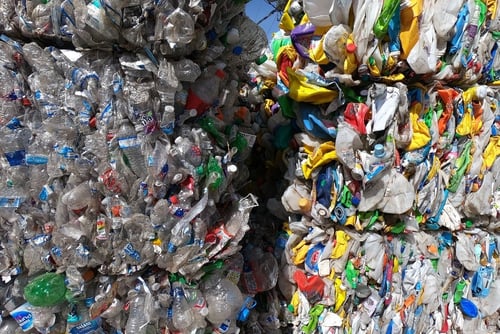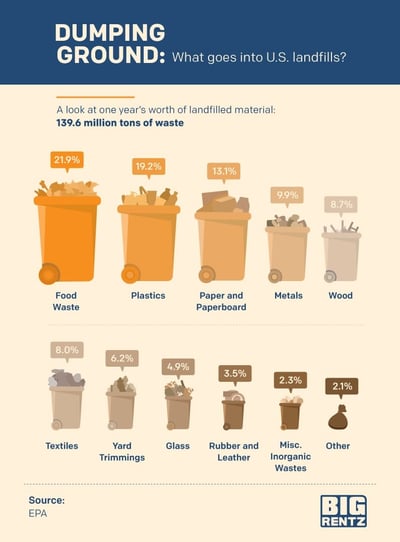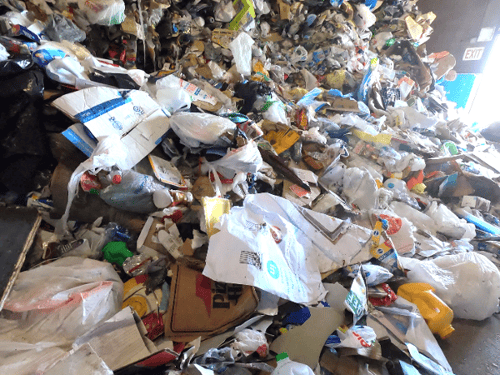3 Things We Learned After Visiting Our Local Recycling Center
As Americans, we create an enormous amount of trash. The average person produces about 4.4 pounds per day, and most of it is comprised of recyclable items.1 To keep up with the increase in curbside pickup volume, landfills have grown in number. We are hearing more about recycling today amidst industry transitions impacted by sustainability initiatives.
Members of our Production, Product Development and Design, Printing, Engineering, Sales, and Marketing team toured the City of McAllen Public Works Recycling Facility to spur open dialogue about sustainability and recyclability. “We are in constant review of our processes in support of our customer’s needs. Understanding the economies that we are contributing to better supports our drive to innovate packaging that protects fresh produce while still being mindful of our environment,” says Raul Acevedo, Sales Manager at Fox Packaging.
1. Incorrect Recycling Habits
Because recycling is ultimately a good thing in consumer perception, many ‘not yet recyclable’ items are making their way to recycling centers in good faith, impeding efforts to collect quality materials to be reprocessed and used in future applications. Good faith recycling increases the amount of unaccepted materials intermingling with accepted applications, complicating the sorting and collection process or even deeming some batches as contaminated.
“Recycling empowers consumers to contribute to a circular economy, reintroducing good material to the system. But when done incorrectly recovery facilities become overwhelmed and ultimately, good recycled material finds its way to a land fill. Recycling comes down to education and innovation”, adds Victoria Lopez, Marketing at Fox Packaging.
What is Accepted (in McAllen)
- Plastics #1 PETE and #2 HDPE
- Cardboard
- Paper
- Aluminum Cans
- Tin
- Glass

Figure 1 Reclaimed PETE (left) and HDPE (right) baled and ready to be shipped out to processors
What types of items come through the stream that areoften perceived as recyclable but are not? |
|
Figure 2 Some materials, like greasy pizza boxes, cannot be recycled, yet still end up in a recycling center.
2. End-Markets Are Scarce
To increase recycling rates, municipalities are testing single-stream recycling.1 Rather than residents sorting plastic, glass, cardboard and paper, it’s all put into the same bin. Waste is then taken to a materials recovery facility, or MRF, for sorting and recycling. While this program has benefits, some cities can’t afford the sorting technology.
“Currently, we only recycle #1 PETE and #2 HDPE plastics, and this is primarily because we do not have end markets for #3 through #7 plastics”, says Marco Ortiz, Recycling Education Coordinator for the City of McAllen Public Works. “In states up north, it is more expensive to landfill recyclable materials than it is to recycle them because, unlike the State of Texas, space for landfills is minimal. To send a ton of trash to the landfill in smaller states, it can cost anywhere between $80 to $140 dollars per ton. The City of McAllen has prioritized recycling in response to pledges made to Keep America Beautiful and we will continue to process our regions recyclables.”
do not have end markets for #3 through #7 plastics”, says Marco Ortiz, Recycling Education Coordinator for the City of McAllen Public Works. “In states up north, it is more expensive to landfill recyclable materials than it is to recycle them because, unlike the State of Texas, space for landfills is minimal. To send a ton of trash to the landfill in smaller states, it can cost anywhere between $80 to $140 dollars per ton. The City of McAllen has prioritized recycling in response to pledges made to Keep America Beautiful and we will continue to process our regions recyclables.”
Today's corporate market development puts a large focus on two areas: 1) overcoming technological barriers such as sorting and recovering materials from a MRF and 2) figuring out what to do with those materials. That includes determining how to get more recycled content products in the marketplace and stimulate demand for them.2
When asked if the center would be able to distinguish a compostable or biodegradable product that came through the recycling center, “We wouldn’t be able to identify that package and sort it out and give it the end-life it was designed for. It would end up being land-filled.”
Unfortunately, roughly 12% to 20% of what a recycling center receives is still sent to a land-fill3. And that data does not include the amount of recycled materials that don’t even make it to the recycling center and go directly to the landfill. Because consumers are navigating recycling incorrectly, it becomes less expensive for a center to landfill in comparison to sorting through the community’s waste. Technology, labor, and hauling becomes costly.
In addition to greater corporate involvement, more industry nonprofits and associations are emerging and working toward solutions — especially as new items are accepted for recycling. For example, The Recycling Partnership and the Carton Council both formed in the past 10 years. These types of organizations launch numerous initiatives to raise awareness about recycling certain materials and using recycled content.2
3. Many Recyclables Are Land-filled
What is in a landfill — food waste, plastics and paper products — account for more than half the garbage accumulated underground.4
 Some developing countries will still accept our sorted materials, Last year, the equivalent of 68,000 shipping containers of American plastic recycling were exported from the US to developing countries that mismanage more than 70% of their own plastic waste.5
Some developing countries will still accept our sorted materials, Last year, the equivalent of 68,000 shipping containers of American plastic recycling were exported from the US to developing countries that mismanage more than 70% of their own plastic waste.5
After China closed their doors to U.S. materials, countries like Malaysia, Indonesia and Vietnam received our materials, improperly mismanaging 81% and 86% of their own materials.5
Ultimately, consumers are neglecting proper recycling practices and in the end, the market for post-consumer bales are not competitive. Addressing the knowledge gap in sustainability is an effort which requires collaboration throughout the value chain. Using packaging as a means of cause marketing and to communicate proper recycling practices can aid in consumers recycling the right way.
To combat waste, begin first with education:
- Start a compost bin, 21.9% of food waste is land-filled, save organic matter that will naturally biodegrade.
- Reuse your packaging, save your Combo Ultra Shield and Fox Fresh mesh bags to use again at the store, not only does this combat waste, but it keeps your food fresh longer.
- Carry a reusable coffee cup, water bottle, straw, and or cutlery.
- Most importantly, talk to your friends and educate as you go.
To ask questions about our packaging and how to educate your consumers, email info@foxbag.com.
1. https://www.dumpsters.com/blog/us-trash-production
2. https://www.wastedive.com/news/what-recycling-end-market-development-looks-like-in-2019/553683/
3. https://mcallenpublicworks.net/
4. https://www.bigrentz.com/blog/which-states-produce-most-trash
5. https://www.theguardian.com/us-news/2019/jun/17/recycled-plastic-america-global-crisis





